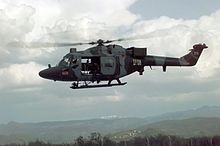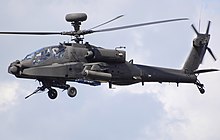Army Air Corps (British Army)
|
Army Air Corps |
|
|---|---|
| Lineup | September 1, 1957 |
| Country |
|
| Type | Corps ( British Army ) |
| insignia | |
| Aircraft cockade |
 
|
The Army Air Corps ( AAC ) of the British Army , the Army Aviation of the United Kingdom .
The headquarters in Middle Wallop in Hampshire are subordinate to the larger units, the operational regiments with their associated squadrons and the smaller flights and other squadrons for training and other purposes. Most of the soldiers are professional soldiers, with the FARP teams (Forward Air Controllers & Refueling Points) comprised in the 6th Regiment being reserve units. The AAC provides the offensive air component of the 16th Air Assault Brigade . The Joint Helicopter Command (JHC) has been responsible for the operational management of all AAC helicopters since 1999 .
history

Aviation in the British Army dates back to before the First World War. By spring 1918 they formed the Royal Flying Corps , which on April 1 was merged with the Royal Naval Air Service to form the independent Royal Air Force (RAF).
The origins of today's Army Air Corps go back to the years of the Second World War. The then Army Air Corps essentially consisted of the then established Glider Pilot Regiment and the Parachute Regiment . The most important mission was the battle for the Pegasus Bridge in Normandy as part of the Allied invasion on D-Day in June 1944. In 1949 the Corps was disbanded.
The two regiments listed above were again combined to form the Army Air Corps in 1957, including the so-called Air Observation Squadrons of the RAF. With the advent of modern turbine helicopters, from the 1960s onwards, more and more helicopters were put into service instead of gliders and fixed-wing aircraft, initially of the Scout and Sioux types , later the Gazelle and Lynx .
In the 2010s there was some restructuring with regard to the arrival of the Wildcat as a Lynx replacement. Yeovilton was selected as the British type base of this aircraft and the previous pure Lynx bases Gütersloh (former home of the 1st regiment) in 2013 and Dishforth (home of the 9th regiment) in 2016 were abandoned. The 5th Regiment's light liaison aircraft , Islander and Defender, were handed over to the RAF in 2019.
In addition to the important stationing in Germany until the end of the Cold War (see below), the Corps was and is in use worldwide. This includes relief and combat missions in Brunei , Belize , Kenya , Bosnia-Herzegovina , Iraq , Afghanistan and not least in Northern Ireland .
Rhine Army
The origins of the later Army Air Corps connection with Germany go back to 1945. The so-called Air Observation Post squadrons of the 2nd Tactical Air Force of the Royal Air Force , whose personnel were jointly provided by the Army and RAF , advanced towards the end of the war with their Auster aircraft after the advancing ground troops to northwest Germany. All but one, the 652nd Squadron , were disbanded by December 1945.
The 652nd Squadron , which was divided into smaller AOP flights from January 1947 , formed the core of the force. After stays in Rhede, Deilinghofen and Hoya , between April 1946 and December 1947, initially Celle , then until May 1949 Lüneburg and from that month the Detmold airfield, the center of the military aviators of the British Army of the Rhine (BAOR, British Rhine Army ) September 1, 1957 in the newly established AAC. In addition, from July 1952 the 1912th Light Liaison Flight , which was initially stationed in Bückeburg and from December 1954 in Wildenrath , and from which the 12th flight of the AAC emerged in 1957 . In addition to the oyster, she flew chipmunks and helicopters, first the Sioux and later the Gazelle .
From the end of the 1970s, the former u. a. Small helicopter force of the Rhine Army equipped with scouts , which at times comprised a third of the British land forces. These included the squadrons of the 3rd regiment in Soest , the 4th regiment in Detmold and the 1st regiment in Hildesheim , each of which was equipped with a mix of Gazelle and Lynx .
After 1990 the size of the British armed forces was significantly reduced, not least in Germany. The two regiments in Soest and Detmold were relocated to the former RAF station Wattisham in Suffolk and the Hildesheim regiment to the former RAF station Gütersloh in East Westphalia . The latter initially consisted of three and from 2000 of two seasons.
As the penultimate unit, the smaller 12th Flight , which had been stationed at the former RAF station Brüggen since June 1992 , was decommissioned in spring 2009 . With the introduction of the new Wildcat-Lynx at the AAC on October 4, 2013 the Gütersloh regiment ceased flight operations, which ended almost 70 years of military flight operations in the United Kingdom in Germany.
The 652nd Squadron mentioned above was one of the last two British squadrons lying on German soil. It was stationed in Germany without interruption between May 1, 1945 and mid-2013, although it had a different name for some time in the late 1960s. In the last weeks of operations of the corps in Germany in late summer 2013, however, the Gütersloh regiment "de facto" only consisted of the 661st Squadron , while the sister squadron was in use in Afghanistan until the end of 2013. The last members of the regiment left Germany the following year for Yeovilton .
organization
The main units of the Army Air Corps are the regiments. Together with the transport helicopters of the Royal Air Force , these are subordinate to the Joint Helicopter Command . The main forces are the 1st , 3rd and 4th Regiments , which together with the 5th and 6th Regiment and the 7th Battalion REME form the deployable 1st Aviation Brigade .
Air bases
The AAC maintains most of its bases in England today , with the School of Army Aviation in Middle Wallop and Wattisham, the Apache type base, as the most important bases. In addition, a base in Northern Ireland is also used in the home country .
- Joint Helicopter Command Flying Station Aldergrove , County Antrim , 5th Regiment with the 665th Squadron (Gazelle)
- SAS Barracks Credenhill , Herefordshire , 8th Flight of the Joint Special Forces Aviation Wing (Dauphine)
- Army Air Corps Middle Wallop , Hampshire , 2nd Regiment with the 671st and 673rd and Air Crewman Training Squadron (Sqirrel, Lynx, Gazelle, Bell 212 and Apache), the 7th Technical Battalion REME as well
- RAF Odiham , Hampshire , 657th Squadron of the Joint Special Forces Aviation Wing (Lynx)
- Wattisham Airfield / Wattisham Flying Station , Suffolk , 3rd and 4th Regiments with the 653rd, 662nd and 663rd and 654th, 656th and 664th Squadron (Apache) and the headquarters of the 1st Aviation Brigade
- RNAS Yeovilton , 1st Regiment with the 652nd, 659th and 661st Squadron (Wildcat)
Outside the UK, AAC units are located at the following locations. The bases "overseas" should continue to be used in the long term and underline Great Britain's claim as a veto power in the UN Security Council .
-
 Belize , Belize City Air Port , 25th Flight (Bell 212)
Belize , Belize City Air Port , 25th Flight (Bell 212) -
 Brunei , Seria, 7th Flight (Bell 212)
Brunei , Seria, 7th Flight (Bell 212) -
 Canada , Suffield , 29. (BATUS) Flight (Bell 212)
Canada , Suffield , 29. (BATUS) Flight (Bell 212)
equipment

The equipment of the AAC (as of the end of 2010) consists mainly of combat helicopters, observation aircraft and smaller helicopters. In contrast to the Army Aviators of the German Army, the medium British transport helicopters are subordinate to the British Air Force.
- Attack helicopter
- 58 Apache AH1 , 0 AH-64E (50 ordered)
- other light emergency aircraft
- 73 Lynx AH7 / AH9 / AH9A multi-purpose helicopters, partly also as transport helicopters for special task forces (AH7 out of service in 2015)
- 0 Wildcat AH1 multipurpose helicopter (34 ordered)
- 28 Gazelle AH1 observation helicopters are to be decommissioned
- 12 Islander AL1, Defender 4S AL1 observation aircraft
- AS 376N3 Dauphin transport helicopter for special operations units
- 7 Bell 212HP AH1 transport helicopters to support ground force training
- Training aircraft
- 2 Islander AL1 trainers
- Squirrel HT2 basic and advanced rotary wing trainer, pooled fleet for all branches of the armed forces
- T67M Firefly 260 basic trainer, pooled fleet for all branches of the armed forces
For sightseeing flights, the AAC headquarters maintains an Army Historic Flight with earlier patterns.
Web links
- Army Air Corps official website
- private website for the history of the 652nd season from 1957
- private website with in-depth information about the Army Air Corps in Germany

